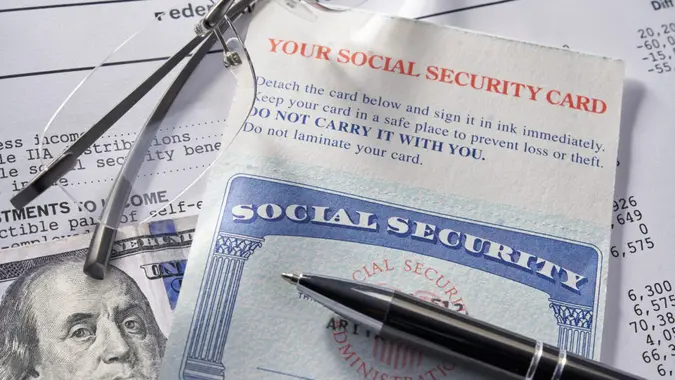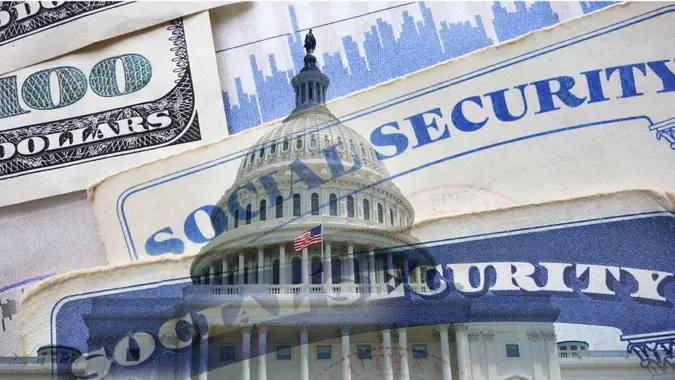I’m a Retiree: Here’s How I Spend My $1,728 Monthly Social Security Check

Commitment to Our Readers
GOBankingRates' editorial team is committed to bringing you unbiased reviews and information. We use data-driven methodologies to evaluate financial products and services - our reviews and ratings are not influenced by advertisers. You can read more about our editorial guidelines and our products and services review methodology.

20 Years
Helping You Live Richer

Reviewed
by Experts

Trusted by
Millions of Readers
After helping clients plan for retirement for decades, accountant Therese R. finally got to experience it herself. Two years into retirement, she’s learned that actually living on Social Security feels very different from the calculations she used to run for other people.
GOBankingRates recently talked with Therese, a retired certified public account (CPA) who worked 35 years before retiring at 67. She shared exactly how she allocates her monthly Social Security payment and what surprised her most about retirement budgeting.
The Real Numbers Behind Social Security
“My Social Security statement shows $2,002 per month, but that’s not what hits my bank account,” Therese explained. After Medicare Part B premiums of $185 and her supplemental insurance, her actual deposit is around $1,728 monthly.
“When you’re planning for retirement, it’s easy to think about the gross benefit amount. When you’re living on it, every deduction matters,” she said. She said to think of it like your paycheck. Sure, you might make a certain amount pretax, but you know your actual take-home pay is quite different. Do the math so you’re not surprised or disappointed.
Housing Eats the Biggest Chunk
Even with a paid-off mortgage, housing costs consume the largest portion of Therese’s budget. “I spend about $780 per month on property taxes, homeowners insurance, utilities and maintenance,” she shared.
Property taxes alone run $385 monthly in her area, while utilities average $165 during normal months. “Summer air conditioning pushes that closer to $220, and it’s just getting more expensive,” she said.
The maintenance costs caught her off guard. “When you’re working and making good money, a $250 plumber visit is annoying but manageable. On a fixed income, it’s a real budget event that requires planning,” Therese said.
Grocery Shopping on a Fixed Income
Therese budgets $320 per month for groceries but typically spends closer to $280. “Years of being careful with money don’t disappear just because you’re retired. I still shop sales and use coupons like I always have,” she explained.
What has changed is how she shops. “I buy more convenience foods now because my time has value too. Precut vegetables cost more, but they’re worth it when you’re cooking for one person,” she said.
Healthcare Beyond Medicare
Despite having Medicare and supplemental insurance, healthcare remains a pretty hefty expense. “I budget $180 monthly for prescriptions, dental care and other medical expenses,” Therese shared.
Dental work presents the biggest wildcard since Medicare doesn’t cover routine dental care. “Last year’s crown cost $1,200, which required dipping into savings,” she said. She also spends about $45 monthly on vitamins and over-the-counter medications.
Transportation and Other Essentials
With a paid-off 2019 Honda Civic that she bought used from a rental car company, Therese still budgets $215 monthly for gas, insurance and maintenance. “Gas runs about $75 monthly, insurance is $88 and the rest goes toward maintenance and surprise repairs,” she explained.
She allows herself $125 monthly for entertainment and personal spending. “I will never let money get in the way of a good time with friends,” Therese said. “If we have to do something cheap or free, we can make it work.”
What Doesn’t Fit in the Budget
“Some things just don’t fit in a $1,728 monthly budget,” Therese admitted. Major home improvements, vacations and unexpected expenses require dipping into her pension and 401(k) savings.
“I try to live primarily on Social Security to preserve other assets for later when I might need assisted living or major medical care,” she explained. “Dementia runs in my family so I’m researching what memory care might look like when the time comes.”
Lessons From the Real World
After two years of living on Social Security instead of planning for it, Therese has learned valuable lessons. “The transition from earning money to spending down assets is psychologically harder than I expected,” she said.
“Inflation hits retirees differently than working people. When grocery prices go up 10%, you can’t just work more hours to cover the difference,” she added.
 Written by
Written by  Edited by
Edited by 

























